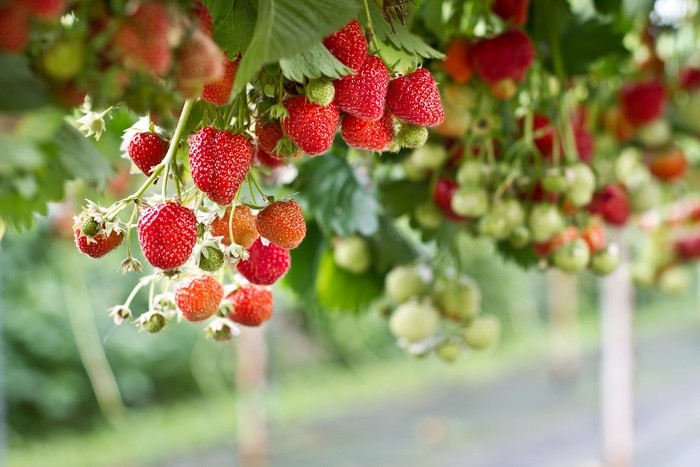草莓树:学习如何种植

Table of contents
一种美味的草莓,容易种植,富含抗氧化剂。


通用名称
草莓树, 草莓树, 高山草莓树。
学名
弗拉格瑞亚 属或 Fragaria x ananassa (两个物种的混合体) F. chiloensis e F. virginiana ).
还有就是 F. vesca (野草莓)和 F. moschata (在大约20个其他可食用的物种中,有一种是 "大果"(比野生的大)。
See_also: 使用洋葱的家庭疗法来源
欧洲( Fragaria x ananassa )--该杂交种来自于秘鲁( F. virginiana ) 和来自智利或阿根廷的( F. chiloensis ).
家庭
蔷薇科
历史事实和奇闻轶事
第一个(野生)草莓品种是在2000年前被驯化的,而更多的商业品种则在250-300年前才诞生。
古罗马人和希腊人在公元23-79年就已经种植了野生草莓树。 普林尼将这种水果描述为 "Fraga"(芳香),是意大利的天然产品。
关于种植草莓树的最早记载只出现在1300年的法国文献中。 据了解,国王查理五世在巴黎卢浮宫的皇家花园中种植了1000多棵草莓树。
直到1766年,Duchesne(法国植物学家)才确定目前的草莓品种是由以下植物杂交出来的 F. chiloensis x F. virginiana 并将其命名为Fragaria x ananassa,以强调来自果实的菠萝香味。
草莓的主要生产国是美国、西班牙和日本。


特征/形态
一种永久性草本植物,有一个中央 "树冠"(气生茎),叶子、根和 "匍匐茎"(臂)、专门的茎(新的植物从那里出现)和花序从那里出现。
叶子是深绿色的,许多叶子在冬天落下,在春天出现新叶。
根系可以达到10-30厘米深,呈束状,有大量的主根(20-30),可以活2-3年。
授粉/受精
如果温度低于11ºC,高于30ºC,日照短,阳光少,以及植物缺硼,草莓花粉就不会发芽。
授粉方式为嗜风虫和嗜昆虫(蜜蜂和熊蜂)。 栽培品种主要是雌雄同体和自育。
生物周期
一年多次,1-3年,但可以是一年一次(大多数人喜欢一年一次),从种植到收获,90-120天。
最广泛种植的品种
有数百个栽培品种,具有不同的光照时间、早熟程度(反刍和非反刍)、栽培系统(无土栽培、露天栽培)和果实的质量特征(大小、形状和含量)。
因此,我们有以下品种:"亚历山大"(高山草莓 "卡马罗萨"(世界上种植最多的)、"塞尔瓦"、"钱德勒"、"大奥索"、"帕哈罗"、"戈雷拉"、"波卡洪塔斯"、"海景"、"图德拉"、"埃尔桑塔"、"霍内伊"、"艾米丽"(早期)、"塔梅拉"、"爱神"、"达尔塞"、"飞马座"、"艾丽丝"、"波列罗"(多年生)、"图腾"、"红杉"(重新组装)。
可食用部分
果实(假果或立体果)是由含有瘦果的肉质花托组成,由种子组成(多瘦果)。
环境条件
气候类型:
温带、亚热带和亚北极以及沙漠气候,具体取决于品种。
土壤:
理想的pH值为5.5-6.7,质地轻或中等,通风,排水良好,富含有机物和保水能力。
温度:
最佳状态(植被):18至25℃。
最小:-30至-12 ºC。
最高:35至40 ºC,取决于栽培品种。
发展停滞:
果实总是需要在-1℃和10℃之间有一定数量的低温时间(250-1500)才能打破休眠(这取决于栽培品种)。
光周期:
欧洲的大多数栽培品种需要8-14小时的阳光。
水的要求:
400-600毫米/年。
大气的湿度:
60-80%的相对湿度。
海拔高度:
从0-1400米。


受精
受精:
使用羊粪、牛粪(充分分解)和虫子粪便。
有机物应该很高,在3.5-4.5%之间。 应向土壤中添加来自岩石的天然钾。
绿肥:
芥末,冬季谷物,三叶草。
营养物质的提取(公斤/公顷):61-135(N),48-85(P),148-218(K)。
营养要求(主要元素清单):
2:1:4或2:1:3(N:P2O5:K2O),加上钙和铁。


栽培技术
土壤准备:
对于绿肥,应使用开角 "勺子 "切割器和圆盘耙进行切割和掩埋。
床的框架可以略微提高(30-40厘米高),将草莓植株放在最高的地方,分成单行、双行或三行。 床之间的距离应该是60-80厘米。
在床铺之间铺上稻草(亚麻、小麦或黑麦)或松针,6-8厘米厚(在路上),并在山脊上放置土壤的除草网,坚固(3-4年)。
乘法:
通过新鲜的根茎和收购树冠直径在11-18毫米之间的草莓植株,以及通过 "树冠 "分割(较少使用的方法)。
种植时,树冠必须在地面上。
种植日期:
在秋季(10-11月),用新鲜的植物。
指南针:
行间50-80厘米,同一行的植物间20-40厘米。
轮换:
冬天的谷物、草、玉米是一个很好的先例。 在回到同一地点之前,你应该有3-4年的休息。
协会:
万寿菊(驱除线虫)、天竺葵、鼠尾草、罂粟、百里香和琉璃苣,对吸引蜜蜂和熊蜂有好处。
豆类、生菜、大蒜、洋葱和菠菜。
悲哀:
草莓植株在种植前可在-1℃下放置几天;在秋季清理所有的干叶和问题叶;修剪和去除多余的树冠(在两年生作物中);去除导引器;在收获后去除花和切下的叶子,只留下中央的新叶(多年生种植园);锄草;控制杂草。
浇水:
在开花期和收获期之间的需求更大。 使用聚乙烯 "T-Tape "型的滴灌系统。
See_also: 护理韭菜周期内耗水量在4000-8000立方米之间。 浇水间隔3-6天。


昆虫学和植物病理学
虫害:
螨虫、蓟马、蚜虫、阿提卡、蛞蝓和蜗牛、线虫和鸟。
疾病:
白粉病、根腐病、轮纹病、灰腐病、炭疽病、镰刀菌、红叶斑病和一些病毒病。
事故/伤害:
缺少铁和硼;对盐度敏感。
收获和使用
何时收获:
人工操作,一旦果实变红,至少要有3/4的表面。
果实应连同花萼和一小部分果柄一起采收。 采收工作应每天或隔天进行。
生产:
60-70吨/公顷/年。
储存条件:
果实非常容易腐烂,所以在0.5-4 ºC和85-95%的相对湿度下,在氧气和二氧化碳的控制下,只能保存5-10天。
最佳消费季节:
四月至六月。
营养价值:
维生素C含量高,是维生素B9、硅、钾、镁、钙、铁和纤维的绝佳来源。
消费的季节:
春夏(5-7月)
用途:
它可以和鲜奶油一起吃,也可用于制作馅饼、冰激凌、酸奶、果酱和许多其他甜点。
药用:
巨大的抗氧化活性(含有花青素),用于治疗风湿病和痛风。 具有利尿、通便和去污的特性。
专家建议:
对于一个四口之家,40-50株就足够了。 草莓应在其自然季节食用。
如果它们不是有机的,应该很好地清洗,因为这些是农药残留最多的水果(它们是污染最严重的前10种水果)。
你喜欢这篇文章吗?
因此,请阅读我们的杂志,订阅Jardins Youtube频道,并在Facebook、Instagram和Pinterest上关注我们。

